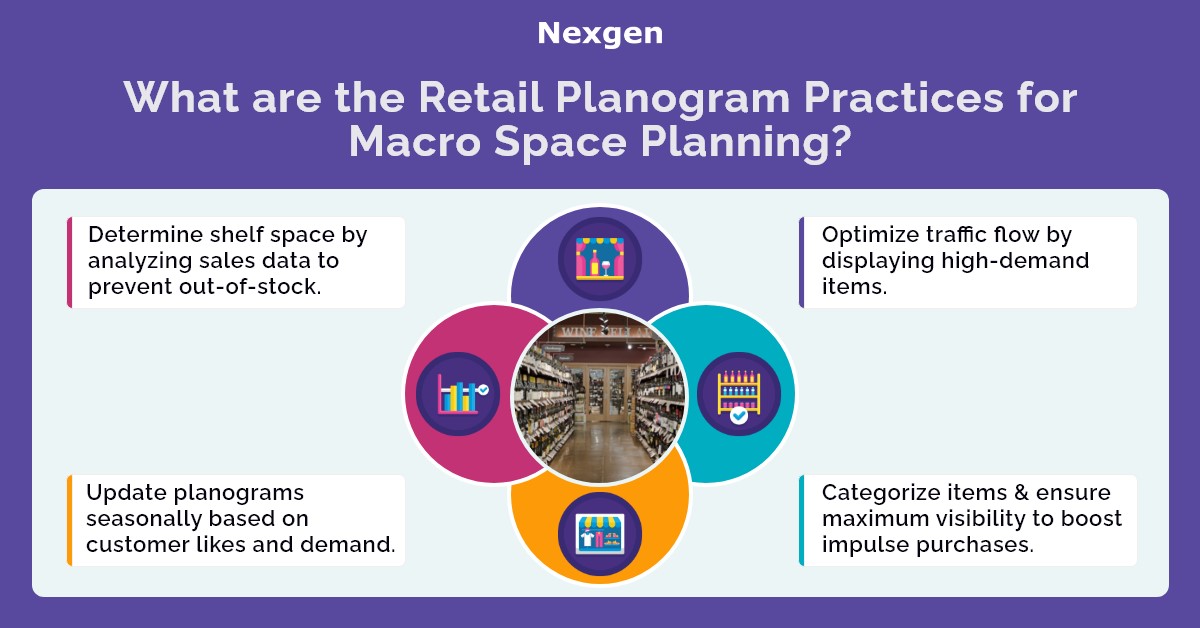In the fast-paced world of retail, optimizing store layout and product placement is crucial to attracting customers, increasing sales, and enhancing the overall shopping experience. Retail planogram practices for macro space planning are instrumental in driving sales and creating a positive shopping experience.
Macro space planning ensures a strategic approach to allocating and arranging products within a store's shelf space. By thoughtfully segmenting categories, optimizing traffic flow, strategically allocating shelf space, and employing smart merchandising strategies, retailers can unlock the full potential of their store layout. Leveraging planogram in retail and staying flexible to changing market dynamics further enhances their ability to meet customer demands successfully. By investing in macro space planning, retailers can transform their stores into customer-centric, efficient, and thriving shopping destinations. In this blog, we will explore the key principles behind successful macro space planning and how retailers can leverage planograms to create an efficient, customer-friendly shopping environment.

- Category segmentation: One of the primary aspects of macro space planning is category segmentation. This involves dividing the store into distinct sections based on product categories. By creating dedicated areas for groceries, apparel, electronics, and more, customers can easily navigate the store and find what they need without confusion. Clear signage and aisles further facilitate seamless navigation. Within each category, retailers can strategically group related products together. This approach simplifies the shopping process and encourages cross-selling. For instance, placing breakfast cereals, oatmeal, and breakfast bars in the same aisle makes it convenient for customers to find all their breakfast needs in one place.
- Optimizing traffic flow: Macro space planning considers customer traffic patterns within the store. High-traffic shelf space can help you display high-demand products or essential items. Placing these items strategically ensures maximum visibility and boosts the likelihood of impulse purchases. For instance, placing complementary products together to encourage additional purchases. Additionally, retailers can implement up-selling tactics by positioning premium or higher-margin products at eye level. You can also utilize gondola end caps at the ends of aisles to display high-margin or seasonal items. This attracts customer’s attention as they move between aisles and can lead to additional purchases.
- Shelf space allocation: Effective shelf space allocation is critical to maintaining a well-organized store. Retailers must analyze sales data and product popularity to determine how much space each item deserves. High-selling products should be given ample shelf space to prevent frequent stockouts, while slow-moving items may require less prominent placement. Create dedicated areas for popular brands of various price ranges within your store. Shoppers often prefer to find all products of a particular brand or price in one place, making it convenient for them to explore and choose.
- Seasonal planning: Staying updated on seasonal trends is a key aspect of macro space planning. Planograms must be updated seasonally to accommodate changes in customer preferences and demands. Highlighting seasonal products and dedicating appropriate shelf space can help maximize sales during specific times of the year. This approach can help maximize sales during specific times of the year when customer demand for seasonal fashion is at its peak.
Overview of Nexgen POG
Nexgen POG is a robust and user-friendly cloud-based visual merchandising tool. It is designed for quick and efficient planogramming with minimal effort. Planogram in retail can be designed by easily dragging and dropping the products. The multi-device compatibility feature of POG allows you to obtain, share and edit planogram on any device, including your phone. It helps in designing store-specific planograms for increased product visibility and sales.
Get Your Free Trial Now!